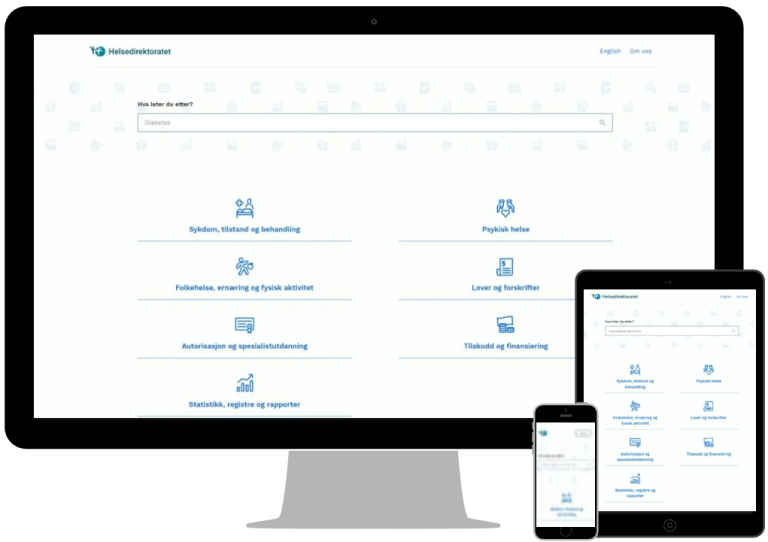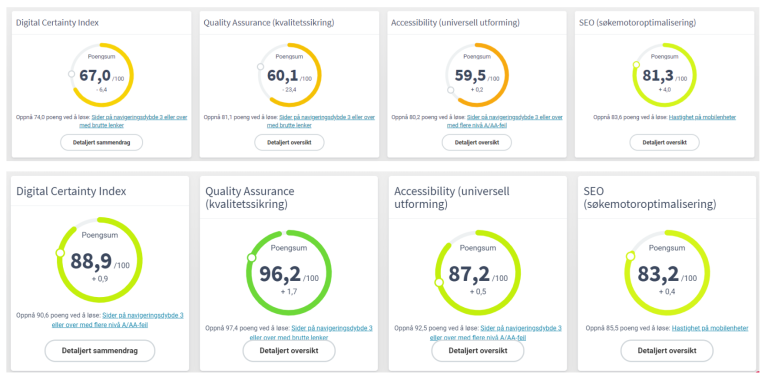Reusable Structured Content Model for HDIR
Addressing both regulation and user expectations, the Norwegian Directorate of Health delivered complex information from several sources via multiple channels to different users—in one solution.

Addressing both regulation and user expectations, the Norwegian Directorate of Health delivered complex information from several sources via multiple channels to different users—in one solution.
The Norwegian Directorate of Health is an executive agency and professional authority under the Ministry of Health and Care Services in Norway. The Directorate acts as an advisor, implements adopted policies, and administers laws and regulations in the healthcare sector. In addition, the Directorate has an overall responsibility for national health preparedness.
In 2013 the Norwegian healthcare authorities developed a strategy aiming for a better health service, based on knowledge and best practice, and with fewer variations. The purpose is to maximize good health in the general population, by ensuring safe quality treatment and care, and a unified health service facing the patients.
A vital part of the mission for the Directorate of Health is to provide good, user-friendly access to health information and services to the following user groups:
The authorities had their own set of requirements as well:
The digital solution of the Directorate of Health consisted of numerous tools—several being outdated. In addition, the integration between the different tools was poor, leading to suboptimal administration of content and services. The specific platform was based on an old SharePoint solution, with quarterly technical updates—a sluggish process requiring six weeks of testing every time.
As for the user situation, physicians, chief physicians, nurses, and other health personnel wanted recommendations in their daily tools, a solution for quick reference, and the possibility of in-depth study when needed. Health professionals also wanted access to guidelines from a single source of authority—instead of finding two differing guidelines on the same condition and patient group. Also, private users were missing information on e.g. their specific rights in a given context.
Another central issue was the ambition to reuse content, both in owned channels and in third-party channels. Large amounts of identical content is written again and again, and when copied to other channels the content often starts to diverge and lose verifiability. To solve this problem, the Directorate needed a platform where content editors could create and maintain content in a way that could easily be pulled out and reused in other contexts—all while keeping the integrity at all times.
It was obvious that the old solution could fulfill neither the user expectations nor the authorities’ requirement of digitalization, reuse, and distribution of content. However, the digital strategy of 2013 had stated a clear road ahead, with emphasis on “what users need, when they need it, where they are.” The decision was made to implement a new digital platform, a new API solution, new websites, and a new content model.

The Directorate of Health needed a solution where all content could be managed from one place, and where it was easy to publish content from different systems. The primary channels of the Directorate are Helsedirektoratet.no for professionals and HelseNorge.no for the general populace. It was required that the digital platform to be chosen must be able to manage both websites, as well as distribute content to other channels facing the target groups.
The Directorate of Health launched a vendor conference in mid-2017, before having meetings with several vendors and agencies. The public procurement process started in January 2018, and in May 2018 the Directorate launched a PoC with three agencies. By June 2018, Netlife was chosen, with 99x as technical subcontractor and Enonic XP as digital platform. The development project began in August 2018, with an initial launch in May 2019.

Enonic XP is open-source and is especially suited for technical agencies like 99x, who can build solutions for effective integration of third-party systems and databases, like medical coding and judicial frameworks. Furthermore, Enonic allows the editors from the Directorate of Health to manage content in accordance with the health authorities’ established reusable content model. Setting up attributes and templates is intuitive, and the reuse of content is enhanced through the structured, content-first nature of Enonic.
Enonic is also a hybrid CMS, enabling functionality from classic CMS and headless CMS in one. This hybrid solution was chosen by Netlife and 99x for the Directorate of Health, in order to e.g. show previews fast and manage landing pages. The content is published to the websites and the Directorate’s API, which again distributes to any specified channel.
A significant part of the Directorate’s work in launching a new and modern digital solution was organizing and structuring the content. Breaking up old PDFs and large pages into semantic pieces is achievable through Enonic’s flexible content model.
The Directorate of Health has managed fields in Enonic’s structured content types to allow for standardized codes from the international health sector. In this way, the Directorate can easily use a term for e.g. diabetes as an independent content item, as part of a wider guideline, or in browsing for diabetes. Enonic’s integrated search engine query both single items and larger items where the search phrase is included as a reusable component.
These content items, both small and large—direct and contextual—and always up to date—can then be reused by third parties. For instance, Legehandboka.no retrieves a diabetes content item from Enonic XP and the Directorate’s API to use in their own article on diabetes.
With Enonic XP, the editors in the Norwegian Directorate of Health have acquired a user-friendly tool allowing them to manage different content types efficiently. The user interface provides a tidy overview, making it easy for the editors to find what they need, when they need it—on both desktop and mobile. The platform is fast and flexible, and has prepared the ground for many exciting projects in years to come. The underlying technology of NoSQL powered by a powerful search engine is highlighted to play an especially important role in this regard.
Search is thus permeating all aspects of the Directorates new website, Helsedirektoratet.no. While browsing through logically arranged topics is readily available on the site, the first thing that meets visitors is a search field—complete with a shifting set of search examples, like “diet kindergarten,” “diabetes,” or “health certificate driver’s license.” As every piece of content can be broken down into both small and large independent parts alike, visitors will find exactly what they are searching for, whether granular or general.
In addition, most of the structured content is available through API. This enables third parties to always have access to the latest versions of treatment recommendations and so on from the Directorate.
The Enonic XP production environment is clustered with three nodes. This ensures high availability and steady and secure handling of traffic spikes in most situations for the Directorate’s digital channels, as well as easy scaling. Another improvement for the Directorate is the frequency of functionality launches and bug fixes. Now these issues can be handled continuously, whereas the release window of the old solution required 3–4 months.
Statistics from the Siteimprove integration in Enonic indicate how well the Directory of Health’s websites perform in digital certainty, quality assurance, accessibility, and SEO. All parameters have increased since launching the new digital solution—especially quality assurance has increased dramatically from 60.1 points to 96.2 points (out of 100). User surveys indicate satisfied users as well: 65% replied they have found what they came for in total, while 74% indicated the same for normative content—i.e. content geared towards health professionals.

The solution for the Directorate of Health is the first of many Enonic-based solutions for the health sector in Norway. 99x has also launched new websites for the Norwegian Health Economics Administration and the Norwegian Directorate of eHealth, with solutions for the Norwegian Radiation Protection Authority and the Norwegian Electronic Health Library under way.
I like Enonic XP, as it is easy and intuitive to work with. Enonic is substantially better than any previous digital platform I have encountered.
Lars Erik Pedersen
Web Editor
Norwegian Directorate of Health

Learn how our customers use Enonic. Get ideas from the many cool projects!

The Norwegian Labor and Welfare Administration used Enonic and Next.js to migrate their massive site to a modern, headless architecture. Without compromising the editor experience.

Learn how the Norwegian Building Authority (DiBK) migrated from Optimizely to Enonic in this detailed case study.

How Enonic and a multinational organization with multiple offices and languages in several countries solved the riddle of localization.